Grotte d’Osselle
Grottes d’Esselles
Useful Information


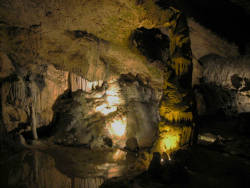
| Location: |
42 route des Grottes, 25410 Roset-Fluans
Near St Vit. From Besançon N73-D13-D48 or D13 through Quingey. (47.1384345, 5.8363609) |
| Open: |
APR to JUN Mon-Sat 14-17, Sun, Hol 10-12, 14-17. JUL to AUG daily 9:30-12, 13-18. SEP to All Saints Holidays Mon-Sat 14-17, Sun, Hol 10-12, 14-17. [2024] |
| Fee: |
Adults EUR 9.50, Children (4-12) EUR 6, Students EUR 7.50. Groups (15+): Adults EUR 7, High School EUR 5, College EUR 4.50, Primary School EUR 4. Cavers ask for reduction. [2024] |
| Classification: |
 Karst Cave Karst Cave
|
| Light: |
 Electric Light Electric Light
|
| Dimension: | L=8,000 m, T=13 °C. |
| Guided tours: | L=1,200 m, D=90 min. |
| Photography: | allowed, no flash |
| Accessibility: | partly wheelchair accessible |
| Bibliography: |
Benjamin Silliman, M.D. LL D (1828):
American Journal of Sciences and Arts,
Vol. XIV, July 1828, New Haven, A.H. Maltby and Hezekiah Howe, Philadelphia.
pp 203-204.
online
|
| Address: |
Grotte d’Osselle, 42 route des Grottes, 25410 Roset-Fluans, Tel: +33-381-636209.
E-mail: Besançon Tourisme Et Congrès, 52 Grande rue (Hôtel de Ville, place du 8 Septembre), 25000 Besançon, Tel: +33-381-80-92-55. E-mail: |
| As far as we know this information was accurate when it was published (see years in brackets), but may have changed since then. Please check rates and details directly with the companies in question if you need more recent info. |
|
History
| 13th century | cave discovered. |
| 1504 | first known visits. |
| 09-SEP-1696 | origin of cave as a river cave first published by Abbé Boisot in the Journal des Savants. |
| 1751 | bridge above the cave river built. |
| 1826 | skeletons of cave bears discovered by the English paleontologist Buckland. |
| 02-MAY-1912 | declared a site classé for multiple criteria. |
| MAY-1967 | during the drilling of tunnels a 400 m long gallery was discovered. |
| 1970 | palaeontological excavation reveals 15 cave bear skeletons. |
Description
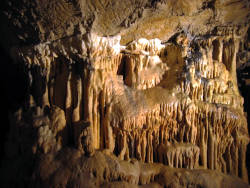

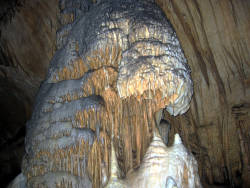
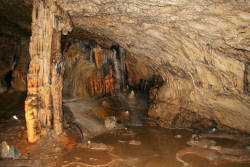
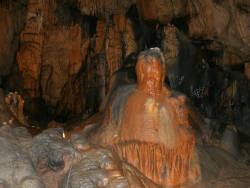

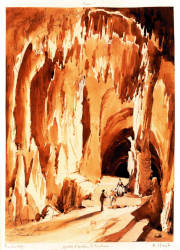
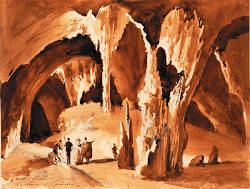
The Grotte d’Osselle is located in a cliff overlooking a meander of the river Doubs. The view from the cave entrance is nice, especially in the evening sun. The entrance of the cave is inside the borders of Osselle and thus the department Doubs, but much of the 8 km long cave system is actually located in the neighboring department Jura.
The cave has a long history as a show cave, guided visits are said to have begun in 1504, although the actual source of this claim is not given.
However, the claim that this is "incontestably the oldest show cave together with the cave of Antiparos" is obviously complete nonsense.
There are several older show caves, see our list of
 Historic Show Caves.
And second, the
Historic Show Caves.
And second, the
 Cave of Antiparos
was actually first used as a show cave in the 19th century.
Cave of Antiparos
was actually first used as a show cave in the 19th century.
The first actually documented cave visit was described by Loïs Gollut (*1535-✝1595). He wrote a very personal description in his Les Mémoires historiques de la République Séquanaise (Historical Memoirs of the Séquanaise Republic). He does not say when he actually visited the cave, but it was before 1592, when the book was published. He was Avocat au Parlement de Dôle (Lawyer at the Dôle Parliament), not a scientist, and so he explained the creation of the cave with an old gold mine exploited by the Romans, which is abandoned because the gold was exhausted. He explained the speleothems by water drops which are freezing in the cold cave and then petrify. And he was convinced those pillars were necessary to prevent the mountain from collapsing. His (ridiculous) theory was refuted by Dunod de Charnage and later by Father Romain Jolly. Their theory, that the cave was formed by rainwater and the underground river was finally published by Father Boisot in the Journal des Savants on 09-SEP-1696.
The underground river in one of the lower galleries is spanned by a small stone bridge enabling visitors to see the so-called Organ Gallery on the other side. It was erected in 1751, the works were ordered by Jean-Louis Moreau de Beaumont, the military Intendant of Franche-Comté. The stones were cut outside the cave, and the workers had to carry them on their back 900 m into the cave, because there was no trail suitable for a cart. Despite the great effort put into this work, the reason why the bridge was built remains unclear. It actually led nowhere at that time. The use of the bridge for the cave tours began 200 years later in 1966, after the discovery of a new passage on the other side. With the bridge it could be easily included in the tour.
In 1758 Lacoré widened narrow passages. In 1763 Toulongeon again widened narrow passages. Why they did this is unclear, probably they were cave guides and wanted to make the tours less strenuous or just longer. Toulongeon organized festivals, banquets and concerts in a dry part of the caves. So there was the speculation that the widening was necessary to allow women with the wide frocks of the time to enter the cave without getting dirty. One section of the cave is really dry, the result of a water-resistant layer above the passage which blocks dripping water from entering. While the lack of water caused a lack of speleothems, it also made the section less uncomfortable for those events. The most famous participant was the philosopher Voltaire, at least according to local lore he participated several times. Due to the lack of speleothems the erosional forms created by the cave river can be seen much better than in the rest of the cave.
During the French Revolution (1789–1799) the cave was used as a refuge by fugitive priests. One of them, Father Griès, is known by name. Most likely they erected the clay altar which dates to that time.
The cave became an important palaeontological site with a worldwide reputation when the great English paleontologist William Buckland (*1784-✝1856) excavated the cave in 1826.
Typically for the 19th century, he was on a guided tour of the show cave when he had the idea that this cave looked similar to the ones in Franconia, Germany, where the cave bear was first described.
So he started to dig with his hammer.
Today he would get expelled, most likely sued, but at that time he was allowed to continue his excavations.
He unearthed the first complete skeleton of a
 Cave Bear (Ursus spelaeus), which he reassembled and exhibited at the British Museum in London.
He sent a part of his discoveries to Paris to Georges Cuvier, the French naturalist and zoologist, who is called the founding father of paleontology.
One of the strange details was the lack of any other bones, obviously the cave bears displaced all other potential cave visitors like hyena.
Georges Cuvier himself later undertook numerous excavations in the cave.
The discovery was published by Silliman in the Volume 14 of the American Journal of Sciences and Arts in July 1828.
As a result, the Osselle cave became internationally famous.
Cave Bear (Ursus spelaeus), which he reassembled and exhibited at the British Museum in London.
He sent a part of his discoveries to Paris to Georges Cuvier, the French naturalist and zoologist, who is called the founding father of paleontology.
One of the strange details was the lack of any other bones, obviously the cave bears displaced all other potential cave visitors like hyena.
Georges Cuvier himself later undertook numerous excavations in the cave.
The discovery was published by Silliman in the Volume 14 of the American Journal of Sciences and Arts in July 1828.
As a result, the Osselle cave became internationally famous.
The cave guides are convinced that William Buckland’s first cave bear is still on display at the British museum. Obviously, they never went there to check. We tried to find it in the online catalogue, which contains 4 Million exhibits, but were not able to find it. While we think that this skeleton is of great importance for the history of science, we would not be surprised to find out, that it was stored to make room for dinosaurs.
The modern tourist trail is 1,200 m long, and more or less level. Most of the cave can actually be visited with a wheelchair, which is quite exceptional. The operators say that the tour covers 15 galleries, a completely arbitrary term, which was quite popular in the 19th century. The cave has many speleothems, mostly stalactites and stalagmites. One of the numerous cave bear skeletons can be seen on the tour, reassembled. To give an impression on how they looked alive there is a small family of cave bears with fur. While size and proportions give a good impression, the cave bears are not really realistic, they look more like huge teddy bears.
Another interesting part of the site is the Musée minéralogique de la Grotte d’Osselle (Mineralogical Museum of the Osselle Cave). This private collection of minerals from all over the world is located in the basement of the cave entrance building. The entrance is at the staircase which leads up from the car park to the ticket office. The museum is open by appointment, the visit and the guided tour are free. We recommend calling ahead to make an appointment, despite the location, the museum is not a part of the show cave, and the cave guides cannot show the museum.
- See also
 Historic Show Caves
Historic Show Caves Cave Bear (Ursus spelaeus)
Cave Bear (Ursus spelaeus) Search DuckDuckGo for "Grotte d’Osselle"
Search DuckDuckGo for "Grotte d’Osselle" Google Earth Placemark
Google Earth Placemark OpenStreetMap
OpenStreetMap Grotte d’Osselle
Grotte d’Osselle  - Wikipedia (visited: 22-MAY-2021)
- Wikipedia (visited: 22-MAY-2021) Grotte d’Osselle, official website
Grotte d’Osselle, official website  (visited: 21-MAY-2021)
(visited: 21-MAY-2021) Grotte d’Osselle at ANECAT (visited: 21-MAY-2021)
Grotte d’Osselle at ANECAT (visited: 21-MAY-2021) Grotte d’Osselle bei Roset-Fluans, Doubs, F, Franz Lindenmayr
Grotte d’Osselle bei Roset-Fluans, Doubs, F, Franz Lindenmayr  (visited: 22-MAY-2021)
(visited: 22-MAY-2021)
 Index
Index Topics
Topics Hierarchical
Hierarchical Countries
Countries Maps
Maps